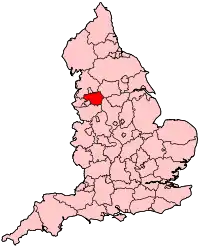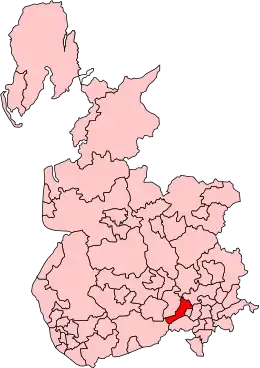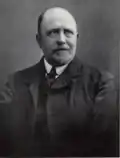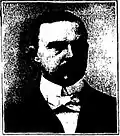Eccles (UK Parliament constituency)
Eccles was a parliamentary constituency of the United Kingdom, centred on the town of Eccles in Greater Manchester, England. It returned one Member of Parliament (MP) to the House of Commons of the Parliament of the United Kingdom, elected by the first past the post system.
| Eccles | |
|---|---|
| Former Borough constituency for the House of Commons | |
 Boundary of Eccles in Greater Manchester for the 2005 general election | |
 Location of Greater Manchester within England | |
| County | Greater Manchester |
| 1885–2010 | |
| Seats | One |
| Created from | South East Lancashire |
| Replaced by | Salford and Eccles, Worsley and Eccles South |
History
The constituency was established under the Redistribution of Seats Act 1885 for the 1885 general election, and abolished at the 2010 general election.
Boundaries

1885–1918
The constituency, known as South East Lancashire, Eccles Division, was defined as consisting of the civil parishes of Barton upon Irwell, Clifton, Flixton, Urmston, Worsley and the part of the parish of Pendlebury not in the Parliamentary Borough of Salford.[1]
1918–83
The Representation of the People Act 1918 redrew all constituencies in Great Britain and Ireland. The Parliamentary Borough of Eccles consisted of two local government districts: the Municipal Borough of Eccles and the Urban District of Swinton and Pendlebury (later incorporated as a borough). The seat was renamed Eccles Borough Constituency by the Representation of the People Act 1948.[1]
1983–97
In 1983 constituency boundaries were altered to align with the new administrative geography introduced by the Local Government Act 1972. Eccles became a borough constituency in the parliamentary county of Greater Manchester, consisting of seven wards of the City of Salford: Barton, Eccles, Pendlebury, Swinton North, Swinton South, Weaste and Seedley, and Winton.[2]
1997–2010
The boundaries of the constituency were altered for 1997 general election, reflecting a change in ward boundaries. It was defined as consisting of the following wards: Barton, Cadishead, Eccles, Irlam, Pendlebury, Swinton North, Swinton South and Winton.[3]
Abolition
Following its review of parliamentary representation in Greater Manchester, the Boundary Commission for England recommended that Eccles be split between two new constituencies:
- Salford and Eccles, from the existing Salford constituency and the central/eastern part of Eccles.
- Worsley and Eccles South, from the existing Worsley constituency and the southern/western part of Eccles.
These constituencies were used from the 2010 general election.
Members of Parliament
Elections
Elections in the 2000s
| Party | Candidate | Votes | % | ±% | |
|---|---|---|---|---|---|
| Labour | Ian Stewart | 19,702 | 56.9 | −7.6 | |
| Conservative | Thelma Matuk | 6,816 | 19.7 | −1.0 | |
| Liberal Democrats | Jane Brophy | 6,429 | 18.6 | +3.8 | |
| UKIP | Peter Reeve | 1,685 | 4.9 | New | |
| Majority | 12,886 | 37.2 | -6.6 | ||
| Turnout | 34.632 | 50.2 | +1.9 | ||
| Labour hold | Swing | −3.3 | |||
| Party | Candidate | Votes | % | ±% | |
|---|---|---|---|---|---|
| Labour | Ian Stewart | 21,395 | 64.5 | −2.2 | |
| Conservative | Peter Caillard | 6,867 | 20.7 | +2.0 | |
| Liberal Democrats | Bob Boyd | 4,920 | 14.8 | +4.1 | |
| Majority | 14,528 | 43.8 | -4.2 | ||
| Turnout | 33,182 | 48.3 | −17.3 | ||
| Labour hold | Swing | -2.1 | |||
Elections in the 1990s
| Party | Candidate | Votes | % | ±% | |
|---|---|---|---|---|---|
| Labour | Ian Stewart | 30,468 | 66.7 | +9.8 | |
| Conservative | Gregory Barker | 8,552 | 18.7 | -10.7 | |
| Liberal Democrats | Bob Boyd | 4,905 | 10.7 | -1.4 | |
| Referendum | John de Roeck | 1,765 | 3.9 | New | |
| Majority | 21,916 | 48.0 | +20.5 | ||
| Turnout | 45,690 | 65.6 | -8.5 | ||
| Labour hold | Swing | +10.2 | |||
| Party | Candidate | Votes | % | ±% | |
|---|---|---|---|---|---|
| Labour | Joan Lestor | 27,357 | 56.9 | +6.1 | |
| Conservative | Gary J. Ling | 14,131 | 29.4 | −1.9 | |
| Liberal Democrats | Geoff C. Reid | 5,835 | 12.1 | -5.8 | |
| Green | Richard C. Duriez | 521 | 1.1 | New | |
| Natural Law | Joan A. Garner | 270 | 0.6 | New | |
| Majority | 13,226 | 27.5 | +8.0 | ||
| Turnout | 48,114 | 74.1 | -0.4 | ||
| Labour hold | Swing | +4.0 | |||
Elections in the 1980s
| Party | Candidate | Votes | % | ±% | |
|---|---|---|---|---|---|
| Labour | Joan Lestor | 25,346 | 50.8 | +4.9 | |
| Conservative | Joy Packalow | 15,647 | 31.3 | -1.9 | |
| SDP | Paul Beatty | 8,924 | 17.9 | New | |
| Majority | 9,699 | 19.5 | +6.8 | ||
| Turnout | 49,917 | 74.5 | +4.4 | ||
| Labour hold | Swing | +3.5 | |||
| Party | Candidate | Votes | % | ±% | |
|---|---|---|---|---|---|
| Labour | Lewis Carter-Jones | 21,644 | 45.9 | -7.7 | |
| Conservative | David H. Philp | 15,639 | 33.2 | -2.6 | |
| Liberal | Kenneth A. Hemsley | 9,392 | 19.9 | +10.1 | |
| Communist | Bert Cottam | 485 | 1.0 | +0.2 | |
| Majority | 6,005 | 12.7 | -5.1 | ||
| Turnout | 47,160 | 70.1 | |||
| Labour hold | Swing | ||||
Elections in the 1970s
| Party | Candidate | Votes | % | ±% | |
|---|---|---|---|---|---|
| Labour | Lewis Carter-Jones | 24,280 | 53.6 | +0.3 | |
| Conservative | J Reid | 16,221 | 35.8 | +4.6 | |
| Liberal | G Knight | 4,448 | 9.8 | −4.9 | |
| Communist | Terry Keenan | 368 | 0.8 | 0.0 | |
| Majority | 8,059 | 17.8 | −4.3 | ||
| Turnout | 45,317 | ||||
| Labour hold | Swing | ||||
| Party | Candidate | Votes | % | ±% | |
|---|---|---|---|---|---|
| Labour | Lewis Carter-Jones | 22,328 | 53.3 | +3.9 | |
| Conservative | Bob Dunn | 13,062 | 31.2 | −1.1 | |
| Liberal | A M Collier | 6,170 | 14.7 | −2.8 | |
| Communist | Terry Keenan | 348 | 0.8 | -0.1 | |
| Majority | 9,266 | 22.1 | +5.0 | ||
| Turnout | 41,908 | ||||
| Labour hold | Swing | ||||
| Party | Candidate | Votes | % | ±% | |
|---|---|---|---|---|---|
| Labour | Lewis Carter-Jones | 22,538 | 49.4 | −6.2 | |
| Conservative | Bob Dunn | 14,752 | 32.3 | -10.6 | |
| Liberal | A M Collier | 7,966 | 17.5 | New | |
| Communist | Terry Keenan | 404 | 0.9 | -0.6 | |
| Majority | 7,786 | 17.1 | +4.4 | ||
| Turnout | 45,660 | ||||
| Labour hold | Swing | ||||
| Party | Candidate | Votes | % | ±% | |
|---|---|---|---|---|---|
| Labour | Lewis Carter-Jones | 23,913 | 55.6 | −3.9 | |
| Conservative | Rhodes Boyson | 18,458 | 42.9 | +5.4 | |
| Communist | Terry Keenan | 643 | 1.5 | -1.5 | |
| Majority | 5,455 | 12.7 | −9.3 | ||
| Turnout | 43,014 | ||||
| Labour hold | Swing | ||||
Elections in the 1960s
| Party | Candidate | Votes | % | ±% | |
|---|---|---|---|---|---|
| Labour | Lewis Carter-Jones | 25,033 | 59.5 | +2.2 | |
| Conservative | Hugh P Holland | 15,776 | 37.5 | −5.2 | |
| Communist | Michael R. Bennett | 1,239 | 3.0 | New | |
| Majority | 9,257 | 22.0 | +7.4 | ||
| Turnout | 42,048 | ||||
| Labour hold | Swing | ||||
| Party | Candidate | Votes | % | ±% | |
|---|---|---|---|---|---|
| Labour | Lewis Carter-Jones | 25,915 | 57.3 | +5.3 | |
| Conservative | John J Hodgson | 19,277 | 42.7 | -5.3 | |
| Majority | 6,638 | 14.6 | +10.6 | ||
| Turnout | 45,192 | ||||
| Labour hold | Swing | ||||
Elections in the 1950s
| Party | Candidate | Votes | % | ±% | |
|---|---|---|---|---|---|
| Labour | William Proctor | 25,566 | 52.0 | -0.4 | |
| Conservative | Brian Robert Osborne Bell | 23,580 | 48.0 | +0.4 | |
| Majority | 1,986 | 4.0 | -0.8 | ||
| Turnout | 49,146 | ||||
| Labour hold | Swing | ||||
| Party | Candidate | Votes | % | ±% | |
|---|---|---|---|---|---|
| Labour | William Proctor | 25,351 | 52.4 | -0.1 | |
| Conservative | Charles P Lawson | 23,025 | 47.6 | 0.0 | |
| Majority | 2,326 | 4.8 | 0.0 | ||
| Turnout | 48,376 | ||||
| Labour hold | Swing | ||||
| Party | Candidate | Votes | % | ±% | |
|---|---|---|---|---|---|
| Labour | William Proctor | 27,941 | 52.5 | +1.8 | |
| Conservative | John Whiteley | 25,330 | 47.6 | +6.6 | |
| Majority | 2,611 | 4.8 | -4.9 | ||
| Turnout | 53,271 | ||||
| Labour hold | Swing | ||||
| Party | Candidate | Votes | % | ±% | |
|---|---|---|---|---|---|
| Labour | William Proctor | 27,409 | 50.7 | -0.4 | |
| Conservative | Harry Sharp | 22,186 | 41.0 | +6.4 | |
| Liberal | J H Jones | 4,477 | 8.3 | -5.5 | |
| Majority | 5,223 | 9.7 | -6.8 | ||
| Turnout | 54,072 | ||||
| Labour hold | Swing | ||||
Elections in the 1940s
| Party | Candidate | Votes | % | ±% | |
|---|---|---|---|---|---|
| Labour | William Proctor | 23,008 | 51.1 | +3.8 | |
| Conservative | Robert Cary | 15,562 | 34.6 | -18.1 | |
| Liberal | Arthur Gerald Pollitt | 6,215 | 13.8 | New | |
| Independent Progressive | Aubrey Bernard Brocklehurst | 211 | 0.5 | New | |
| Majority | 7,446 | 16.5 | N/A | ||
| Turnout | 44,996 | ||||
| Labour gain from Conservative | Swing | +10.9 | |||
Elections in the 1930s
| Party | Candidate | Votes | % | ±% | |
|---|---|---|---|---|---|
| Conservative | Robert Cary | 22,310 | 52.7 | -9.1 | |
| Labour | J Grierson | 20,055 | 47.3 | +9.1 | |
| Majority | 2,255 | 5.4 | -18.2 | ||
| Turnout | 42,365 | ||||
| Conservative hold | Swing | ||||
| Party | Candidate | Votes | % | ±% | |
|---|---|---|---|---|---|
| Conservative | John Potter | 26,049 | 61.8 | +32.0 | |
| Labour | David Mort | 16,101 | 38.2 | -11.6 | |
| Majority | 9,948 | 23.6 | N/A | ||
| Turnout | 42,150 | ||||
| Conservative gain from Labour | Swing | ||||
Elections in the 1920s
| Party | Candidate | Votes | % | ±% | |
|---|---|---|---|---|---|
| Labour | David Mort | 20,489 | 49.8 | +3.0 | |
| Unionist | Albert Bethel | 12,232 | 29.8 | −23.4 | |
| Liberal | Handel Wilde | 8,374 | 20.4 | New | |
| Majority | 8,257 | 20.0 | N/A | ||
| Turnout | 41,095 | 81.9 | −0.8 | ||
| Registered electors | 50,203 | ||||
| Labour gain from Unionist | Swing | +13.2 | |||
| Party | Candidate | Votes | % | ±% | |
|---|---|---|---|---|---|
| Unionist | Albert Bethel | 16,833 | 53.2 | +17.0 | |
| Labour | John Buckle | 14,798 | 46.8 | +4.0 | |
| Majority | 2,035 | 6.4 | N/A | ||
| Turnout | 31,631 | 82.7 | +4.5 | ||
| Registered electors | 38,257 | ||||
| Unionist gain from Labour | Swing | +6.5 | |||
| Party | Candidate | Votes | % | ±% | |
|---|---|---|---|---|---|
| Labour | John Buckle | 12,227 | 42.8 | −8.6 | |
| Unionist | Marshall Stevens | 10,364 | 36.2 | −12.4 | |
| Liberal | William Sandiford Ashton | 6,011 | 21.0 | New | |
| Majority | 1,863 | 6.6 | +3.8 | ||
| Turnout | 28,602 | 78.2 | +0.5 | ||
| Registered electors | 36,585 | ||||
| Labour hold | Swing | +1.9 | |||
| Party | Candidate | Votes | % | ±% | |
|---|---|---|---|---|---|
| Labour | John Buckle | 14,354 | 51.4 | New | |
| Unionist | Marshall Stevens | 13,551 | 48.6 | −33.7 | |
| Majority | 1,803 | 2.8 | N/A | ||
| Turnout | 27,905 | 77.7 | +22.3 | ||
| Registered electors | 35,912 | ||||
| Labour gain from Unionist | Swing | N/A | |||
Elections in the 1910s

| Party | Candidate | Votes | % | ±% | |
|---|---|---|---|---|---|
| C | Unionist | Marshall Stevens | 15,821 | 82.3 | +34.7 |
| Liberal | Richard Durning Holt | 3,408 | 17.7 | −34.7 | |
| Majority | 12,413 | 64.6 | N/A | ||
| Turnout | 19,229 | 55.4 | −30.5 | ||
| Registered electors | 34,702 | ||||
| Unionist gain from Liberal | Swing | +34.7 | |||
| C indicates candidate endorsed by the coalition government. | |||||
| Party | Candidate | Votes | % | ±% | |
|---|---|---|---|---|---|
| Liberal | George Pollard | 8,467 | 52.4 | +11.4 | |
| Conservative | John Campbell | 7,676 | 47.6 | +8.9 | |
| Majority | 791 | 4.8 | +2.4 | ||
| Turnout | 16,143 | 85.9 | −6.1 | ||
| Registered electors | 18,786 | ||||
| Liberal hold | Swing | +1.3 | |||
| Party | Candidate | Votes | % | ±% | |
|---|---|---|---|---|---|
| Liberal | George Pollard | 7,093 | 41.0 | +2.2 | |
| Conservative | G F Assinder | 6,682 | 38.7 | +3.9 | |
| Labour | G. H. Stuart-Bunning | 3,511 | 20.3 | -6.1 | |
| Majority | 411 | 2.4 | -1.6 | ||
| Turnout | 17,286 | 92.0 | +2.5 | ||
| Registered electors | 18,786 | ||||
| Liberal hold | Swing | −0.9 | |||
Elections in the 1900s

| Party | Candidate | Votes | % | ±% | |
|---|---|---|---|---|---|
| Liberal | George Pollard | 5,841 | 38.8 | −10.3 | |
| Conservative | T Stuttard | 5,246 | 34.8 | −16.1 | |
| Labour Repr. Cmte. | Ben Tillett | 3,985 | 26.4 | New | |
| Majority | 595 | 4.0 | N/A | ||
| Turnout | 15,072 | 89.5 | +7.1 | ||
| Registered electors | 16,832 | ||||
| Liberal gain from Conservative | Swing | +2.9 | |||

| Party | Candidate | Votes | % | ±% | |
|---|---|---|---|---|---|
| Conservative | Octavius Leigh-Clare | 6,153 | 50.9 | -1.0 | |
| Liberal | John Fry | 5,934 | 49.1 | +1.0 | |
| Majority | 219 | 1.8 | -2.0 | ||
| Turnout | 12,087 | 82.4 | −2.9 | ||
| Registered electors | 14,674 | ||||
| Conservative hold | Swing | −1.0 | |||
Elections in the 1890s
| Party | Candidate | Votes | % | ±% | |
|---|---|---|---|---|---|
| Conservative | Octavius Leigh-Clare | 5,722 | 51.9 | +3.2 | |
| Liberal | Henry John Roby | 5,302 | 48.1 | -3.2 | |
| Majority | 420 | 3.8 | N/A | ||
| Turnout | 11,024 | 85.3 | −1.2 | ||
| Registered electors | 12,917 | ||||
| Conservative gain from Liberal | Swing | +3.2 | |||
| Party | Candidate | Votes | % | ±% | |
|---|---|---|---|---|---|
| Liberal | Henry John Roby | 5,340 | 51.3 | +3.1 | |
| Conservative | Octavius Leigh-Clare | 5,071 | 48.7 | −3.1 | |
| Majority | 269 | 2.6 | N/A | ||
| Turnout | 10,411 | 86.5 | +2.0 | ||
| Registered electors | 12,040 | ||||
| Liberal gain from Conservative | Swing | +3.1 | |||
| Party | Candidate | Votes | % | ±% | |
|---|---|---|---|---|---|
| Liberal | Henry John Roby | 4,901 | 51.1 | +2.9 | |
| Conservative | Algernon Egerton | 4,696 | 48.9 | -2.9 | |
| Majority | 205 | 2.2 | N/A | ||
| Turnout | 9,597 | 86.2 | +1.7 | ||
| Registered electors | 11,136 | ||||
| Liberal gain from Conservative | Swing | +2.9 | |||
Elections in the 1880s
| Party | Candidate | Votes | % | ±% | |
|---|---|---|---|---|---|
| Conservative | Algernon Egerton | 4,277 | 51.8 | +0.4 | |
| Liberal | Ellis Duncombe Gosling | 3,985 | 48.2 | -0.4 | |
| Majority | 292 | 3.6 | +0.8 | ||
| Turnout | 8,262 | 84.5 | −6.2 | ||
| Registered electors | 9,781 | ||||
| Conservative hold | Swing | +0.4 | |||
| Party | Candidate | Votes | % | ±% | |
|---|---|---|---|---|---|
| Conservative | Algernon Egerton | 4,559 | 51.4 | ||
| Liberal | Vernor Kirk Armitage | 4,312 | 48.6 | ||
| Majority | 247 | 2.8 | |||
| Turnout | 8,871 | 90.7 | |||
| Registered electors | 9,781 | ||||
| Conservative win (new seat) | |||||
Notes and references
- Youngs, Frederic A, Jr. (1991). Guide to the Local Administrative Units of England, Vol.2: Northern England. London: Royal Historical Society. pp. 815, 818. ISBN 0-86193-127-0.
{{cite book}}: CS1 maint: multiple names: authors list (link) - The Parliamentary Constituencies (England) Order 1983 (S.I. 1983/417)
- "The Parliamentary Constituencies (England) Order 1995 (S.I. 1995/1626)". Office of Public Sector Information. 1995. Retrieved 11 December 2009.
- Leigh Rayment's Historical List of MPs – Constituencies beginning with "E" (part 1)
- "Election Data 2005". Electoral Calculus. Archived from the original on 15 October 2011. Retrieved 18 October 2015.
- "Election Data 2001". Electoral Calculus. Archived from the original on 15 October 2011. Retrieved 18 October 2015.
- "Election Data 1997". Electoral Calculus. Archived from the original on 15 October 2011. Retrieved 18 October 2015.
- "Election Data 1992". Electoral Calculus. Archived from the original on 15 October 2011. Retrieved 18 October 2015.
- "Election Data 1987". Electoral Calculus. Archived from the original on 15 October 2011. Retrieved 18 October 2015.
- "Election Data 1983". Electoral Calculus. Archived from the original on 15 October 2011. Retrieved 18 October 2015.
- "UK General Election results, May 1979". Political Science Resources. Archived from the original on 28 June 2017. Retrieved 12 December 2009.
- "UK General Election results, October 1974". Political Science Resources. Archived from the original on 28 August 2016. Retrieved 12 December 2009.
- "UK General Election results, February 1974". Political Science Resources. Archived from the original on 1 July 2017. Retrieved 12 December 2009.
- "UK General Election results, 1970". Political Science Resources. Archived from the original on 24 September 2015. Retrieved 12 December 2009.
- "UK General Election results, March 1966". Political Science Resources. Archived from the original on 16 June 2015. Retrieved 12 December 2009.
- "UK General Election results, October 1964". Political Science Resources. Archived from the original on 16 June 2015. Retrieved 12 December 2009.
- "UK General Election results, October 1959". Political Science Resources. Archived from the original on 24 September 2015. Retrieved 12 December 2009.
- "UK General Election results, February 1955". Political Science Resources. Archived from the original on 3 March 2016. Retrieved 12 December 2009.
- "UK General Election results, October 1951". Political Science Resources. Archived from the original on 24 September 2015. Retrieved 12 December 2009.
- "UK General Election results, February 1950". Political Science Resources. Archived from the original on 14 July 2015. Retrieved 12 December 2009.
- "UK General Election results, July 1945". Political Science Resources. 11 March 2008. Archived from the original on 11 August 2011. Retrieved 12 December 2009.
- "The General Election. First Returns". The Times. 15 November 1935. p. 9.
- "The General Election. First Returns". The Times. 20 October 1931. p. 6.
- "The General Election. First Returns". The Times. 31 May 1929. p. 6.
- "The General Election. First Returns". The Times. 30 October 1924. p. 6.
- "The General Election. First Returns". The Times. 7 December 1923. p. 6.
- "The General Election. First Returns". The Times. 16 November 1922. p. 7.
- "General Election, 1918 - The Polls". The Times. 30 December 1918. p. 16.
- "Progress of the General Election". The Times. 8 December 1910. p. 7.
- Craig, FWS, ed. (1974). British Parliamentary Election Results: 1885-1918. London: Macmillan Press. ISBN 9781349022984.
- "Progress of the General Election". The Times. 22 January 1910. p. 6.
- "Progress of the General Election". The Times. 25 January 1906. p. 10.
- "Progress of the General Election". The Times. 11 October 1900. p. 8.
- "The General Election. Unionist Gains in the Counties and in Wales". The Times. 19 July 1895. p. 6.
- "The General Election. The Polls". The Times. 15 July 1892. p. 4.
- "Election Intelligence Lancashire (Eccles Division)". The Times. 23 October 1890. p. 5.
- "The New Parliament". The Times. 7 July 1886. p. 6.
- "The General Election. The Polls". The Times. 1 December 1885. p. 11.